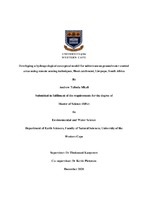| dc.contributor.advisor | Kanyerere, Thokozani | |
| dc.contributor.advisor | Pietersen, Kevin | |
| dc.contributor.author | Mkali, Andrew Talinda | |
| dc.date.accessioned | 2021-03-24T08:05:57Z | |
| dc.date.available | 2022-01-01T22:10:06Z | |
| dc.date.issued | 2020 | |
| dc.identifier.uri | http://hdl.handle.net/11394/8028 | |
| dc.description | >Magister Scientiae - MSc | en_US |
| dc.description.abstract | Crystalline basement aquifers are an important source of water supply in sub-Saharan Africa for various purposes. These aquifers are characterized by fractured rock networks which form pathways for groundwater recharge, flow, and discharge in subterranean groundwater areas. The fractured rock networks in these areas form fractured rock aquifers which in some cases are protected or reserved. In South Africa, various aquifers with these characteristics have been declared as subterranean groundwater control areas. The physical characteristics of these hydrogeological settings remains crucial in sustaining ecosystems and supporting socio-economic practices such as irrigation, among others. However, the role of fracture connectivity in crystalline basement aquifers remains poorly understood despite the well-established knowledge about the hydrogeological characteristics of such areas. | en_US |
| dc.language.iso | en | en_US |
| dc.publisher | University of the Western Cape | en_US |
| dc.subject | Aquifer characterization | en_US |
| dc.subject | Crystalline basement | en_US |
| dc.subject | Groundwater potential | en_US |
| dc.subject | Conceptual model | en_US |
| dc.subject | Groundwater | en_US |
| dc.title | Developing a hydrogeological conceptual model for subterranean groundwater control areas using remote sensing techniques, Hout catchment, Limpopo, South Africa | en_US |
| dc.rights.holder | University of the Western Cape | en_US |

